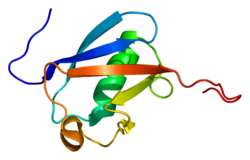Top Qs
Timeline
Chat
Perspective
OASL
Protein-coding gene in the species Homo sapiens From Wikipedia, the free encyclopedia
Remove ads
59 kDa 2'-5'-oligoadenylate synthetase-like protein is an enzyme that in humans is encoded by the OASL gene.[5][6]
2'-5'-oligoadenylate synthase is a protein family of structurally similar proteins, including OAS1, OAS2, and OAS3. However, mutations in the OAS domain mean it lacks the motif to allow oligomerization, preventing the synthesis of oligoadenylates. OASL, like the proteins of 2'-5'-oligoadenylate synthase family, is induced by interferons.
Remove ads
Function
RNA Virus Infection
In RNA virus infection, viral genetic material binds to the RNA sensor RIG-I, triggering a reaction cascade that culminates in the secretion of type I interferons.[7] OASL acts as a sensitiser of RIG-I, binding to the caspase activation and recruitment domain and enhancing interferon production.[8]
DNA Virus Infection
While OASL has an anti-viral role in RNA viral infection, it has also demonstrated a pro-viral role in DNA viral infection.[9] OASL can bind to the viral DNA sensor cGAS, inhibiting its catalytic activity and preventing the secretion of interferons.[10]
Intracellular Bacterial Infection
OASL is shown to be upregulated during a wide variety of vacuolar and cytosolic bacterial infections.[11] It possesses an ability to inhibit autophagic mechanisms and antimicrobial peptide secretion within the host cell through unclear mechanisms, preventing clearance of the pathogen and creating a favourable intracellular environment.[12]
Remove ads
See also
References
Further reading
Wikiwand - on
Seamless Wikipedia browsing. On steroids.
Remove ads







